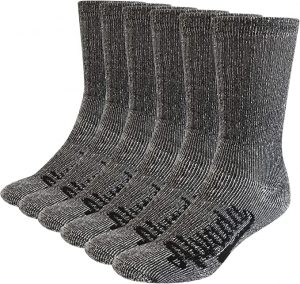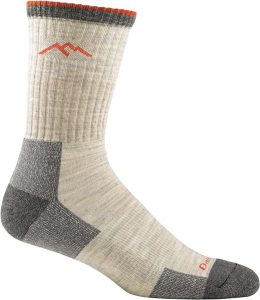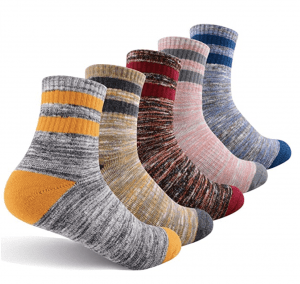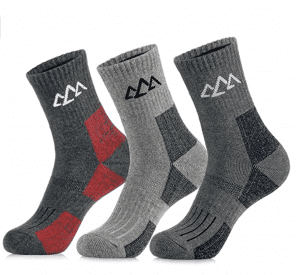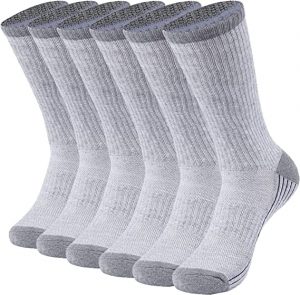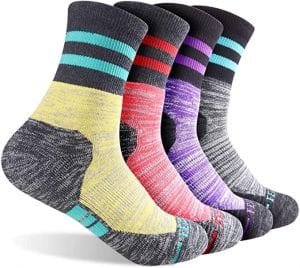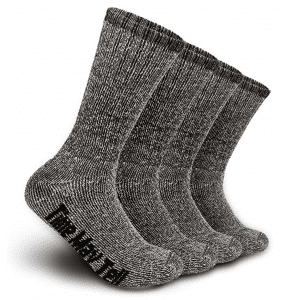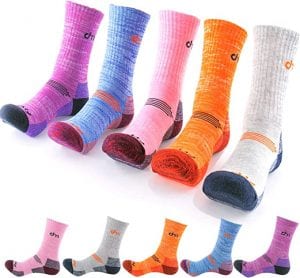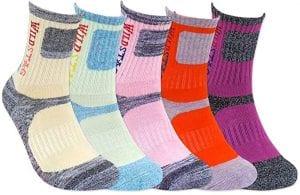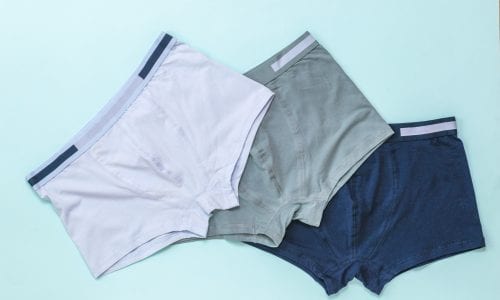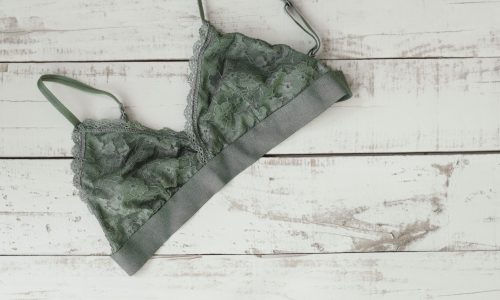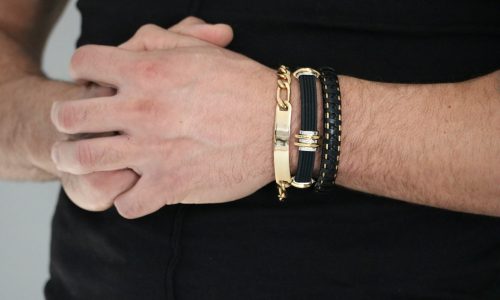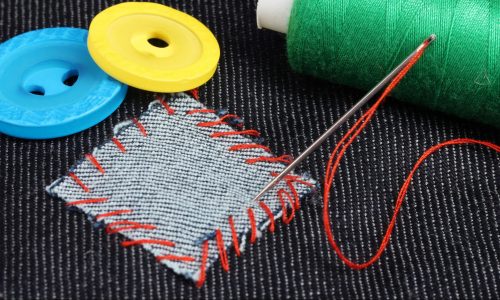The Best Hiking Socks
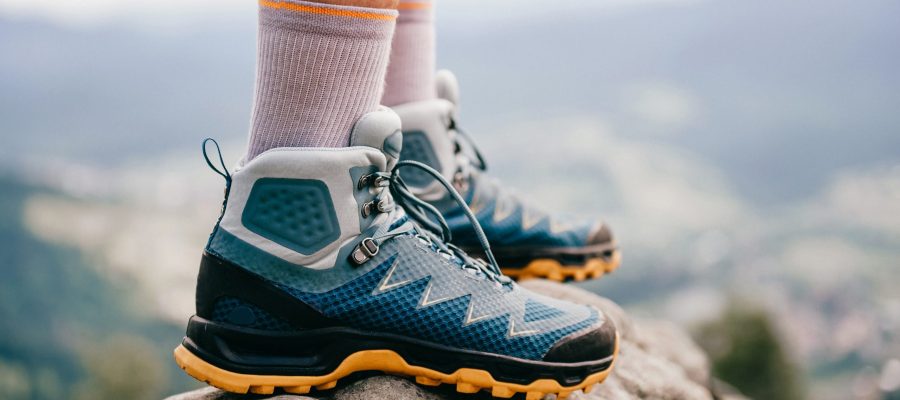
Our Review Process
Don't Waste Your Money is focused on helping you make the best purchasing decision. Our team of experts spends hundreds of hours analyzing, testing, and researching products so you don't have to. Learn more.
Our Picks For The Top Hiking Socks
- 1. Alvada Itch-Free Thermal Hiking Socks, 3-Pack
- 2. Darn Tough Anti-Blister Breathable Hiking Socks
- 3. FEIDEER Wicking Cushioned Hiking Socks, 5-Pack
- 4. innotree Cushioned Reinforced Heel & Toe Hiking Socks, 3-Pack
- 5. Sunew Bamboo Machine Washable Hiking Socks, 6-Pack
- 6. FEIDEER Moisture Control Socks, 4-Pack
- 7. Time May Tell Professional Merino Wool Hiking Socks, 4-Pack
- 8. DearMy Cotton Ventilating Hiking Socks, 5-Pack
- 9. WILD STAG Cushioned Hiking Socks, Multi-Pack
These thermal socks for men offer all-day comfort with superior cushioning. They are ideal for hiking and other outdoor activities. The socks are made with a wool and synthetic blend so they aren’t itchy.
Superior ComfortThese thermal hiking socks for men have cushioning in the footbed.
Warmth and comfort is what you can expect from these stylish hiking socks, as they are made using a merino wool. Since they also contain spandex, the socks are flexible enough to move with your body. The seams are also made to be undetectable, so you won't have to worry about itching or irritation.
Fashionable ChoiceThanks to the moisture-wicking properties of these hiking socks, sweat isn't an issue.
These cotton-polyester-spandex socks feature a thickened towel bottom design to keep feet from getting fatigued. They also have elasticized arch braces to keep the sock from twisting and elastic ribbed cuffs to prevent drooping. The unique moisture-wicking technology keeps feet from sweating.
Great for Long DaysThe exclusive moisture-wicking technology in these hiking socks helps keep your feet dry.
With cushioning along the foot bottom and a compressed top, you'll have support and comfort whether you're wearing these socks for hiking or everyday use. The socks are made using fine-gauge knitting with reinforced stitching at the heel and toe. They're made from a cotton, nylon and lycra spandex blend.
Comfort is KeyThese hiking socks are fully cushioned on the bottom to provide extra support and softness.
Buying Guide
Socks play an important role in your comfort throughout the day. The right cushioning supports your foot while elastic in all the proper places ensures your socks stay in place. But if you’re going for a hike, socks take on even greater importance.
Why do you need a good pair of hiking socks? Over the miles you’ll be trekking, blisters and abrasions can provide a point of pressure and pain that will slow you down as you grow more uncomfortable. The right socks will help keep your shoes from rubbing against your skin and keep your feet warm and protected while you walk
But moisture can be a big problem, too. As you walk, sweat can build up between your socks and foot, leading to an environment that allows bacteria to grow. The socks you choose should be made from moisture-wicking material to keep your feet dry no matter what your activity.
Many hikers prefer Merino wool as the main material in hiking socks, as this material is anti-microbial, quick-drying and soft. Polyester and cotton provide a lightweight build, but you’ll need to make sure they have the padding necessary to keep your feet well-supported. Nylon is also a preferred fabric because of its durability and quick-drying properties. If you are sensitive to these materials, bamboo makes a good alternative fabric for the perfect hiking socks. You may wish to look for a blend with Spandex, which provides stretch and helps socks hold their shape.
What to Look For
- There are four heights for hiking socks: no-show, which provide only enough coverage for low-profile footwear such as trail-running shoes; ankle, which is best for lower-cut shoes; crew socks, which fall above your ankle bone; and knee-high, which are best if you’re wearing boots.
- When choosing socks, consider your footwear. Tall boots require tall socks. Roomy shoes may allow you to add cushioning or layers for extra warmth. Tighter shoes can require a lighter-weight style. Socks will also come in sizes that correspond to your shoe size, but you’ll want to know the size of your actual foot if you prefer to buy slightly larger shoes.
- Most socks come in multi-pair sets. If a variety of colors is important to you, you can find assortments that will let you shake things up.
- Having your socks slip downward throughout the day can be annoying whether you’re hiking or not. When you’re on a trail, though, it can slow you down and lead to an uncomfortable experience. Look for socks with an elasticized band, or ones which use compression to hold the socks in place.
- Socks can also slide around inside your shoe while you’re wearing them. This can put the extra cushioning where you don’t need it, like on the side of your foot instead of the bottom. Some hiking socks are designed to prevent this movement, so your socks stay firmly in place the entire time you’re wearing them. Look for a Y-shaped, constructed heel.
More to Explore
Hiking can be tough on your feet. Blisters, sore muscles and even long-term foot problems can result from your hiking excursions, so it’s important to prepare before you hit the trail.
One of the most important things you can do is ease the burden on your feet. This means lightening the load of your backpack, paring it down to only the most essential items. Also, make sure you have a pack that evenly distributes the weight across your body. You should also invest in proper footwear and change your hiking boots out often as the tread starts to wear down.

